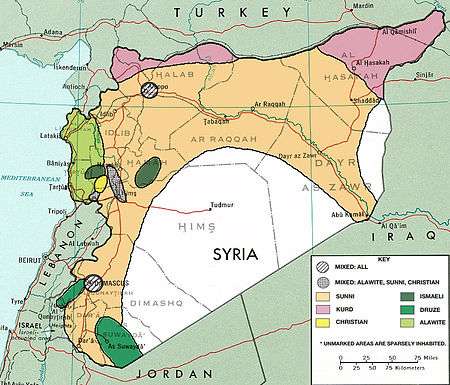Ethnic groups in Syria
Syria is a multi-ethnic country, made up of several ethnic groups.

Map from Joseph Holliday, The Struggle for Syria in 2011, Institute for the Study of War
.jpg)
Map from La cartothèque de l'Ifpo (Institut français du Proche-Orient)
Ethnicity, religion and national/ideological identities
Ethnicity and religion are intertwined in Syria as in other countries in the region, but there are also nondenominational, supraethnic and suprareligious political identities, like Syrian nationalism.
Counting the ethnic or religious groups
Since the 1960 census there has been no counting of Syrians by religion, and there has never been any official counting by ethnicity or language. In the 1943 and 1953 censuses the various subcreeds were counted separately, e.g. for every Christian denomination. In 1960 Christians were counted as a whole but Muslims were still counted separately between Sunnis, Alawis and Druzes.[1] [2] [3]
Syrians and "foreigners"
Before the Civil War began in 2011, the Syrian population was estimated at roughly 23 million permanent inhabitants, including between 1,000,000 and 1,500,000 Iraqi refugees of various ethnicities and creeds, 580,000 Palestinian refugees, mostly Sunni Arabs, and an unknown number of Lebanese or Lebanese-Syrian dual citizens, mostly Shia Arabs and Christian Arabs of various subcreeds. Palestinians and Lebanese had been living in Syria sometimes since several generations. More than four million refugees, Syrians as well as "Non-Syrians" have left the country during the course of the Civil War.
Ethnoreligious groups
Most Syrians speak Arabic, most are Sunni Muslims, but there are no accurate numbers or percentages of the various "majority" and "minority" groups. Sunni Arab Syrians could be anywhere between 60% and 69% as non-Arabic-speaking groups (mostly Kurds) are usually estimated at about 4%, non-Sunni Muslim groups (mostly Alawis) at more than 20% and Arabic-speaking Christians are 10%, but these are only indicative percentages.
- Muslim minority groups
- Kurds (most Syrian Kurds are Sunni)
- Arabic-speaking or Turkmen Alawis[4]
- Arabic-speaking Druzes
- Arabic-speaking Ismailis
- Arabic-speaking (Syrian, Lebanese, Iraqi) and Iranian Twelver Shias
- Sunni Muslim (and also Christian) Palestinians
- Sunni and Alawi Turkmens
- Sunni Circassians
- Sunni Muslim Greeks
- Christian minority groups
- Arabic-speaking Christians (Greek-Orthodox, Greek-Catholics, Maronites and a part of the Syrian Catholics)
- Assyrians (Catholics) and Syriacs (Orthodox)
- Armenians
- Other groups
- Romani people of various creeds
- Jews
- Yazidis are an ethno-religious group and Yezidism (Sharfadin) is one of the oldest Religion.
(probably none or a handful in 2016)
See also
- Demographics of Syria
- Languages of Syria
- Religion in Syria
- Sectarianism and minorities in the Syrian Civil War
- Federalization of Syria
References
- ↑ Hourani, Albert Habib (1947). Minorities in the Arab World. London: Oxford University Press. p. 76.
- ↑ French: Etienne de Vaumas, "La population de la Syrie", Annales de géographie, Année 1955, Vol. 64, n° 341, p.74
- ↑ French: Mouna Liliane Samman, La population de la Syrie: étude géo-démographique, IRD Editions, Paris, 1978, ISBN 9782709905008 table p.9
- ↑ "Syrian Alawites, referred to by AKP officials as Nusayris — a derogatory term not accepted by most Alevis in Turkey or Alawites in Syria — indeed can briefly be explained as follows. Some are Turkmen. They speak Turkish (...)" cf. Pinar Tremblay, "Syrian Alawites hope for change in Turkey", Al-Monitor, November 15, 2013
External links
- Sectarianism in Syria (Survey Study)
- "Syria". World Directory of Minorities and Indigenous Peoples. Minority Rights Group International.
- "Guide: Syria's diverse minorities". BBC. 2011.